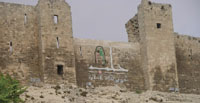
In praise of times pastAleppo, Capital of Islamic Culture 2006 [Archives:2007/1014/Culture]
January 8 2007
 |
A metal ball monument has been the talk of the town in Aleppo for months. In the city's central Saadallah al-Jabiri Square, across from the monument to those who fell in the struggle for independence against France, what is reputed to be the Middle East's largest metal ball has become the setting for a variety of cultural events. Many of the city's inhabitants however are not particularly impressed.
The illumination of the square has also incurred their wrath given the problems that the city's electricity supply is prone to.
But it is the improvement work on Saadallah al-Jabiri Square that is to thank for Aleppo's selection as one of this year's Capitals of Culture. The Organisation of the Islamic Conference has decided that each year three cities from the Islamic world are to be chosen as Capitals of Islamic Culture. They are to be presented to the world as showcases of Islamic civilisation.
Last year it was Mecca, birthplace of Islam, which was chosen as inaugural city. This time round the honour is being shared by Aleppo, Isfahan and Timbuktu.
A hub of Islamic high culture
Mohammad Kujjah, director of the archaeological society and of the general secretariat in charge of the festivities in Aleppo is proud of his city's performance in beating off competition from Damascus, Istanbul and Cairo to fulfil the criteria set by the Conference of Islamic States.
In his office, close to Aleppo's historic citadel, he is in his element expounding on the history of Halab, as the city was known in the second century BC. This north Syrian city, which is one of the oldest continuously inhabited in the world, became a UNESCO World Heritage Site in 1986.
The imposing citadel, the mosques, churches, schools, khans, hammams, covered souks and hospitals reflect all epochs of Islamic history. High-water mark in the city's history came during the rule of the Hamdanid prince Saif ad-Daula in the 10th century, with his court becoming a magnet for prominent men of letters and scholars such as the poet al-Mutanabi and the mathematician al-Khawarizmi.
A hopeless task
For centuries the city was an important trading centre. Today it is still home to a multi-ethnic, multi-faith population. Aleppo is also associated with prominent figures from the period of the Arab Renaissance or nahda, such as the writer Abdarrahman al-Kawakibi or the literary family Marrash.
It's a rich heritage, and one which the programme of events is intended to reflect. Something of a hopeless task though, as Mohammad Kujjah explains: \”Really


